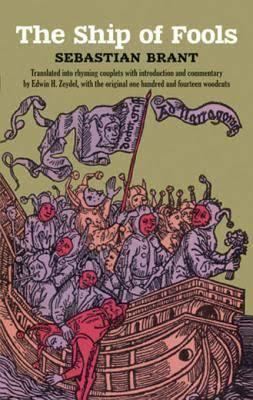Originally published 1494 | ||
 | ||
Similar Madness and Civilization, The Praise of Folly, Simplicius Simplicissimus, Nuremberg Chronicle, Publii Virgilii Maronis | ||
Ship of Fools (Modern German: Das Narrenschiff, Latin: Stultifera Navis, original medieval German title: Daß Narrenschyff ad Narragoniam) is a satyrical allegory in German verse published in 1494 in Basel, Switzerland, by the humanist and theologian Sebastian Brant. It is the most famous treatment of the ship of fools trope and circulated in numerous translations.
Overview
The books consists of a prologue, 112 brief satires, and an epilogue, all illustrated with woodcuts. Brant takes up the ship of fools trope, popular at the time, lashing with unsparing vigour the weaknesses and vices of his time. Here he conceives Saint Grobian, whom he imagines to be the patron saint of vulgar and coarse people.
The concept of foolishness was a frequently used trope in the pre-Reformation period to legitimise criticism, as also used by Erasmus in his Praise of Folly and Martin Luther in his "An den christlichen Adel deutscher Nation von des christlichen Standes Besserung" (Address to the Christian Nobility). Court fools were allowed to say much what they wanted; by writing his work in the voice of the fool, Brant could legitimise his criticism of the church.
The work immediately became extremely popular, with six authorised and seven pirated editions published before 1521. Brant's own views on humanism and the new, revolutionary views on Christianity emerging in the sixteenth century are unclear. The debate still continues whether the Ship of Fools is itself a humanist work or just a remnant of Medieval sensibilities.
The book was translated into Latin by Jakob Locher in 1497, into French by Pierre Rivière in 1497 and by Jean Drouyn in 1498, into English by Alexander Barclay in 1509 and by Henry Watson also in 1509.
Most of the woodcuts of the first edition are attributed to the Meister der Bergmannschen Offizin, who may have been the young Albrecht Dürer. The additional wood-cuts are the work of the so-called Haintz-Nar-Meister, the gnad-her-Meister and two other anonymous artists.
An allegorical painting by Hieronymus Bosch, The Ship of Fools, a fragment of a triptych said to have been painted by Bosch between 1490 and 1500, may have been influenced by the frontispiece for the book. It is on display in the Louvre Museum in Paris.
Some 20th-century artists (including Art Hazelwood, Dušan Kállay, István Orosz, Richard Rappaport, Brian Williams) made images based on "Das Narrenschiff", or drew illustrations for contemporary editions of The Ship of Fools.
